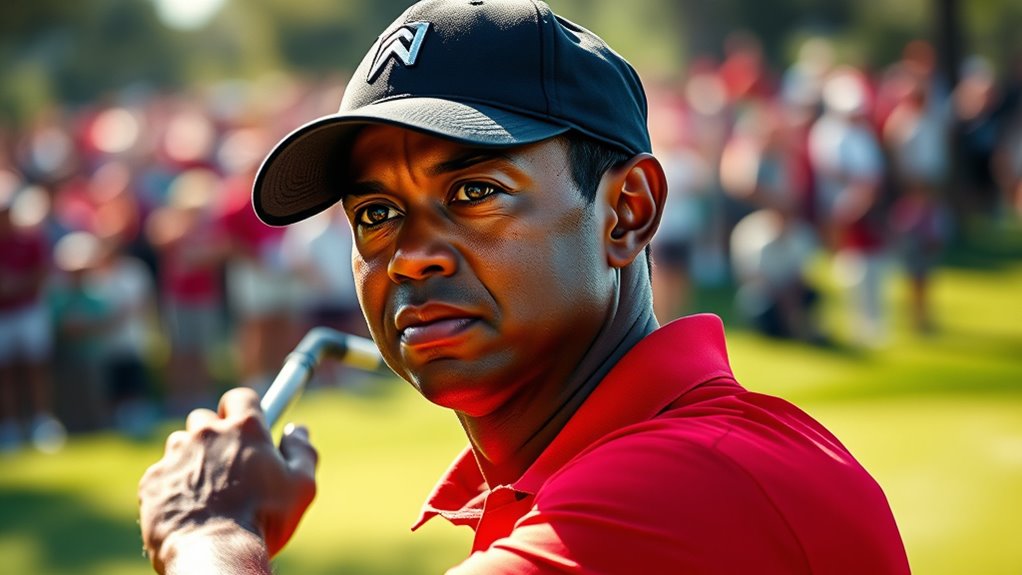Tiger Woods’ journey is a remarkable story of resilience and determination, showcasing unprecedented comebacks amid injuries and personal struggles. From dominating golf as a young prodigy to overcoming surgeries, setbacks, and scandals, he repeatedly defied the odds with his relentless work ethic and mental strength. His record-breaking victories, including multiple Masters titles, inspire millions. Stick around to discover how Woods transformed setbacks into legendary triumphs that forever changed golf history.
Key Takeaways
- Overcame multiple severe injuries, including back surgeries and leg fractures, demonstrating extraordinary resilience.
- Achieved a historic 2019 Masters win after a 11-year major title drought and spinal fusion surgery.
- Rebounded from personal scandals, mental health struggles, and a winless period to regain top form.
- Continued to compete at the highest level, tying the PGA Tour record with 82 career wins.
- Showcased mental toughness and strategic recovery, inspiring a new era of perseverance in professional golf.
Early Career and Rapid Rise to Prominence

Tiger Woods’s journey to stardom began early, as he quickly made a name for himself in junior golf by winning multiple titles in the early 1990s. His talent was evident, and by age 16, he competed in his first PGA tournament at the 1992 Los Angeles Open, aiming to become the youngest player in PGA history. Even without winning, he gained valuable experience and celebrity status among golfers. In fall 1994, he enrolled at Stanford on a golf scholarship, winning his first collegiate event that September. Woods excelled academically and athletically, earning honors like Pac-10 Player of the Year. By 18, he became the youngest U.S. Amateur champion, securing three consecutive titles and breaking racial and age barriers, setting the stage for his future dominance. Early Amateur Success He had already won three consecutive US Amateur titles as a child, laying the foundation for his legendary career through amateur accomplishments. His early experiences in competitive golf were strengthened by a mindset focused on positive thinking, which helped him overcome challenges and stay motivated throughout his career.
Record-Breaking Peak Performances and Achievements

Throughout his career, Woods set numerous records that cemented his status as one of the greatest golfers of all time. You can’t ignore his 15 major titles, including a record 12-stroke victory at the 1997 Masters and a 15-stroke win at the 2000 U.S. Open. His “Tiger Slam”—winning four consecutive majors—demonstrates his dominance. He holds the PGA Tour record for 52 consecutive rounds at par or better and shares the record with 82 career wins, tying Sam Snead. Woods also defended titles 24 times and achieved a streak of seven consecutive wins. His consistency kept him at the top of world rankings for a record-breaking number of weeks. These achievements not only highlight his peak performance but also establish him as a true legend of the game. He is the only golfer to win all four professional majors consecutively (the Tiger Slam, 2000–2001), which remains a unique feat in golf history. Additionally, Woods’ ability to maintain competitive longevity over decades underscores his enduring excellence in the sport. His commitment to player development and resilience have inspired countless aspiring athletes worldwide. Furthermore, his dedication to training and preparation has been pivotal in his sustained success. His strategic approach to keto diet and fitness routines has played a significant role in maintaining his competitive edge.
Navigating Injury and Surgery Challenges

Facing numerous injuries and surgeries over his career, Woods has demonstrated remarkable resilience and determination. You see, he’s battled knee issues, including surgeries to remove cysts and repair torn ligaments, often playing through pain. His back has required multiple surgeries, like microdiscectomies and fusion procedures, which impacted his game markedly. Wrist injuries also challenged his swing, needing extensive rehab but no major surgeries. The 2021 car crash added a new hurdle, with severe leg injuries and emergency surgeries, demanding long recovery and mental strength. Despite these setbacks, Woods kept pushing forward, showing unwavering focus. Here’s a quick overview:
| Injury Type | Key Surgeries/Challenges |
|---|---|
| Knee Injuries | Tumor removal, ACL fracture, cartilage cleanup |
| Back Surgeries | Microdiscectomy, spinal fusion |
| Car Accident & Recovery | Compound leg fractures, rehab |
Additionally, embracing failure as a step in his recovery process has helped him build resilience, continually seeking innovative approaches to return to peak performance. Moreover, advancements in medical technology have played a crucial role in enabling his rehabilitation and recovery efforts. These technological innovations have enhanced rehabilitation protocols, allowing for more effective and personalized recovery plans.
Personal Struggles and Taking Time Off

When facing personal struggles, you realize taking strategic time off can be essential for recovery. By focusing on family and addressing your challenges privately, you can rebuild trust and strength. This pause allows you to come back with a renewed sense of purpose and resilience. Earl Woods’ death marked a profound emotional loss for Tiger, impacting his mental state and performance, highlighting the importance of taking time to heal. Additionally, managing your emotional well-being through personal finance management can provide stability during difficult times, allowing you to focus on recovery. Incorporating mental health strategies can further support emotional resilience during this period, especially when considering outdoor living and design that promote relaxation and stress relief. Recognizing the significance of emotional well-being as a key component of overall health can also aid in your journey toward recovery.
Overcoming Personal Challenges
Tiger Woods’ journey to overcome personal challenges began with a difficult period of self-reflection and recovery after a series of scandals and setbacks. After the 2009 car accident and revelations of extramarital affairs, you faced intense media scrutiny and public disappointment. You took a self-imposed break from golf from December 2009 to April 2010 to address personal and marital issues. During this time, you focused on healing with your family, but your performance suffered, with no wins in 2010—your first winless year since turning pro. The table below illustrates some of these struggles:
| Personal Scandals | Mental Recovery | Professional Impact | Public Reaction |
|---|---|---|---|
| Media scrutiny | Time off for healing | Win drought of 30 months | Mixed public support |
| Divorce finalized | Rebuilding confidence | Performance decline | Media criticism |
| Endorsements lost | Facing negative coverage | Struggled to regain form | Disappointment & support |
| Public image tarnished | Motivation fueled comeback | Intermittent success | Ongoing scrutiny |
Additionally, your dedication to personal growth and resilience played a crucial role in eventually overcoming these hurdles and returning to top form. Recognizing the importance of industry trends helped you adapt your approach and regain competitiveness. Incorporating vibrational alignment into your mindset was key to shifting your outlook and attracting positive opportunities. Moreover, a renewed focus on mental health awareness contributed to your overall recovery, emphasizing the significance of consistent self-care routines. A focused effort on exfoliation and skin renewal contributed to your overall recovery, emphasizing the importance of self-care and revitalization.
Strategic Time Away
Strategic time away from professional golf often plays a crucial role in a player’s ability to recover from personal and physical setbacks. Early in your career, you managed minor injuries with brief pauses, staying mostly present in major tournaments. These short layoffs involved self-rehab and reinforcement training, helping you stay competitive without major disruptions. The 2008 knee injuries marked your first significant break, following surgery after the Masters, yet you played through pain to win the U.S. Open. Your back surgeries between 2014 and 2017 required extended recovery periods, involving months of rehab and careful planning. More recently, after a severe 2021 car accident, you took time to heal gradually, prioritizing safety and quality of life over immediate competition. These deliberate breaks allowed your body to recover while preserving your competitive spirit. Recovery time for the injuries and surgeries has varied depending on the severity, but each period of rest was essential for a full comeback. Recognizing the importance of personal health management has been crucial in maintaining your longevity in the sport. Additionally, understanding the need for strategic breaks has helped you adapt and extend your career at the highest level. Incorporating advanced recovery techniques has also contributed significantly to your resilience and sustained performance. Moreover, utilizing innovative medical treatments has played a vital role in accelerating your healing process and returning to peak form.
Focus on Family
Family has played a crucial role in Tiger Woods’ life, shaping both his personal journey and his approach to golf. Earl Woods introduced him to golf at age two and served as his primary coach, instilling discipline and focus. Tida Woods emphasized a strong work ethic and connected Tiger to his Thai heritage, influencing his values. During his personal struggles, especially after the 2009 infidelity scandal and divorce, his family’s support became even more vital. Despite media scrutiny and injuries, Tiger’s family remained a steady source of motivation. His wife Elin and their children provided emotional grounding, helping him regain focus on his career. Family’s encouragement fueled his resilience, ultimately guiding him through setbacks toward a remarkable comeback. Their influence remains central to his renewed success. In fact, Tiger’s family has also been a source of comfort during moments of loneliness and private reflection, helping him stay grounded amid public and personal challenges. Additionally, the strength of family bonds can serve as a vital source of support, especially during periods of intense pressure and change. Recognizing the importance of family support systems has been key to his sustained perseverance and eventual triumph. Moreover, engaging in mindfulness practices such as meditation and visualization could have helped him manage stress and maintain focus during his recovery. These practices are supported by textile art techniques that promote focus and emotional expression, which can be beneficial during stressful periods.
The Resurgence: Historic Comebacks and Major Wins

You’ve seen Tiger Woods overcome serious injuries and personal setbacks, proving his resilience. His record-breaking streak of comebacks, culminating in major victories, shows how he defies the odds. This chapter highlights his remarkable journey of recovery and relentless pursuit of greatness. His 2019 Masters win marked one of the most inspiring moments in golf history, demonstrating his ability to return to the top despite long-standing challenges.
Major Victory After Injury
Tiger Woods’ remarkable ability to win major championships after sustaining serious injuries exemplifies resilience and determination. In 2008, he claimed the U.S. Open despite a double stress fracture in his left tibia and ACL damage, showcasing his toughness. After years of setbacks, Woods returned to victory at the 2018 TOUR Championship, his first PGA Tour win in five years. Then, in 2019, he secured his fifth Masters title following spinal fusion surgery, proving his resilience. Woods often recovers quickly from surgeries, adapting his training to manage injuries effectively. Early injuries, surgeries, and setbacks demonstrate his incredible capacity to persevere through physical adversity. These victories highlight his exceptional ability to overcome physical challenges and stay competitive at the highest level. His major wins after injury not only define his career but also serve as inspiring milestones in golf history.
Overcoming Personal Setbacks
Despite facing significant personal setbacks that threatened to overshadow his career, Woods showed remarkable resilience by tackling his issues head-on and eventually making a powerful comeback. His highly publicized divorce from Elin Nordegren in 2010, coupled with scandals and infidelity disclosures, led to a self-imposed hiatus from golf starting in December 2009. Woods lost multiple sponsorships and faced intense media scrutiny, which damaged his reputation. During this time, he focused on personal growth, taking responsibility, and working on family reconciliation. Publicly, he admitted his failings and expressed regret for letting others down. Through emotional struggles and intense pressure, Woods maintained his commitment to recovery, rebuilding his personal integrity while preparing to return to professional golf stronger than ever.
Record-Breaking Comeback Streak
Tiger Woods’ comeback streak stands as one of the most remarkable in sports history, exemplifying resilience and determination. After his last major win in 2008, you witnessed Woods defy the odds, winning the 2019 Masters and ending a decade-long drought. His 15 major championships, including five Masters and a record 82 PGA Tour victories, showcase his sustained excellence. Overcoming severe back injuries, including spinal fusion surgery in 2017, Woods returned to compete at the highest level, even winning the Tour Championship in 2018. His 2019 Masters victory was historic—his first major win without leading after the third round. Woods’ ability to rebound from setbacks and compete with top players again cemented his legacy as one of golf’s greatest and inspired countless fans worldwide.
Overcoming Physical Limitations and Rehabilitative Triumphs

Overcoming physical limitations requires relentless dedication and innovative rehabilitation strategies. You’ve seen how Tiger Woods has faced multiple surgeries, including back, ankle, and Achilles tendon procedures, each demanding intense recovery efforts. His persistent back issues and recent Achilles rupture in March 2025 meant adapting and pushing through pain. Woods’ commitment to personalized rehab programs, advanced surgical techniques, and expert medical guidance has been essential. He’s adjusted his swing mechanics, modified practice schedules, and adopted injury prevention strategies like core strengthening and flexibility exercises. His use of cutting-edge technology and mental resilience has helped him rebuild strength and confidence. Each setback tested his resolve, but his unwavering focus turned injuries into opportunities for growth, proving that recovery is as much about mental toughness as physical healing. Understanding the importance of a comprehensive treatment plan has also played a significant role in his journey back to peak performance.
Milestones That Define a Legendary Career

Few players in golf history have achieved the level of dominance and consistency that define Tiger Woods’ legendary career. With 15 major championships—second only to Jack Nicklaus—you’ve witnessed him win five Masters, four PGA Championships, three U.S. Opens, and three Open Championships. His 82 PGA Tour victories tie him with Sam Snead for the most all-time, and he’s won three majors in a single year twice. Woods uniquely held all four major titles simultaneously during the “Tiger Slam,” and he became the youngest player to complete the career Grand Slam at just 24. His 11-year streak of winning at least one major, and his record-setting 12-stroke victory at the 1997 Masters, cement his status as a true legend. These milestones mark his unparalleled impact on golf.
The Impact of Resilience on Golf’s History

Resilience has become a defining trait in golf’s history, shaping how players confront challenges and recover from setbacks. You see, resilient golfers control their emotions, manage stress, and stay focused despite poor shots or external pressures. This mental toughness helps them grind through tough rounds and bounce back quickly from mistakes, often turning setbacks into comebacks. Physical resilience, built through targeted training, reduces injuries and improves recovery, allowing players to maintain consistency over grueling schedules. Resilience also fuels perseverance during career slumps, enabling players to stay motivated and push forward. Over time, stories of resilience—like Rory McIlroy’s comeback—highlight how mental and physical toughness have shaped golf’s evolution, inspiring new generations to persist in pursuit of greatness. Tiger Woods exemplifies resilience through his numerous comebacks from injuries and personal setbacks, inspiring countless golfers worldwide.
Legacy and Inspiration for Future Generations

Tiger Woods’s extraordinary achievements have left an indelible mark on golf, shaping its history and inspiring countless players around the world. You see his 82 PGA TOUR victories tying the record, and his 15 major titles, including the historic “Tiger Slam,” showcasing unmatched dominance. He became the youngest to complete the career Grand Slam at 24, proving that greatness can be achieved early. His record-breaking milestones, like reaching 100, 200, and 300 wins, motivate future golfers to push boundaries. Woods’s resilience and work ethic serve as a powerful example, encouraging others to overcome setbacks. Beyond the course, his philanthropic efforts through the TGR Foundation and his influence on golf’s popularity and diversity inspire generations to dream bigger and endeavor harder. His legacy continues to shape the sport’s future.
Frequently Asked Questions
How Did Tiger Woods Manage to Maintain Top Performance Despite Multiple Injuries?
You manage top performance by staying disciplined with your physical care and adapting your game to your injuries. You follow rigorous rehab routines, modify your swing mechanics, and incorporate strength and flexibility training. You strategically pick tournaments to avoid overexertion, and you stay mentally focused despite setbacks. With support from medical experts and a strong work ethic, you push through pain, continuously refining your skills to stay at the top.
What Specific Training or Techniques Did Woods Use During His Recovery Periods?
Think of your recovery like tuning a vintage car—you need patience, precision, and the right tools. During his rehab, Woods shifted from heavy weights to bodyweight exercises to boost mobility and reduce re-injury risk. He incorporated gradual movement, like walking stairs, used compression sleeves for support, and practiced golf-specific drills. This careful, adaptive approach helped him rebuild strength, regain skills, and stay focused mentally, ensuring a steady comeback.
How Has Woods’S Personal Life Affected His Professional Golf Career?
Your personal life has profoundly impacted your professional golf career. The 2009 scandal damaged your public image and sponsorships, causing a career slowdown. Your divorce and personal struggles led to periods of absence from the tour, affecting your performance. Injuries and recovery also limited your playtime. Despite these challenges, your focus on family and resilience helped you regain your footing, demonstrating your commitment to both personal growth and professional success.
What Are Woods’s Plans for Future Tournaments and Career Longevity?
You see, Woods is carefully shaping his path forward. While he’s still healing from a recent injury, he plans to participate in select big PGA Tour events and continue in TGL matches. Though his comeback isn’t tied to a specific date, his focus remains on regaining competitiveness and extending his remarkable career. With resilience and strategic planning, he aims to leave a lasting impact, inspiring fans and aspiring golfers alike.
How Does Woods’S Comeback Influence Current and Upcoming Golf Professionals?
You see how Woods’s comeback inspires current and future golf professionals by showing resilience and mental toughness. His ability to overcome injuries and setbacks encourages you to stay focused during tough times. Woods’s example pushes you to prioritize physical fitness, disciplined training, and strategic play. His story reminds you that setbacks aren’t the end, but opportunities to grow, innovate, and stay committed to your goals in golf.
Conclusion
Like a phoenix rising from ashes, you witness Tiger Woods’s journey—a relentless force reborn through perseverance. His story echoes a river carving its path through mountains, carving strength with each obstacle faced. You see how resilience fuels the flame of his legend, inspiring generations to embrace their own battles. His comeback isn’t just a victory in golf; it’s a confirmation to the unbreakable spirit within us all, forever shaping the course of history.










